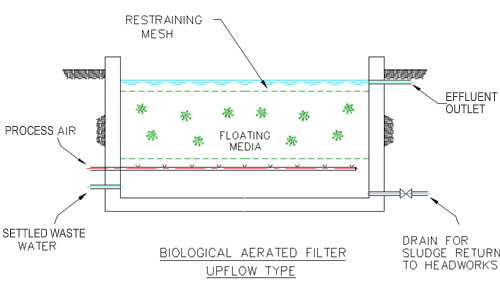Biological aerated filter
Biological aerated filtering
The biological aerated filter (BAF) has a 2-3m deep bed of relatively small size filter media, to provide a high surface area, on which to grow a biomass. The filter bed is submerged and a settled wastewater is pumped either upwards or downwards through the filter. A blower sends air through a diffuser at the bottom of the bed which generates bubbles which then rise through the filter providing a steady stream of oxygen for the biomass to support the oxidation process.
Trapped solids and a growing biomass gradually block the filter pathways and these obstructions are cleared from time-to-time by air-scouring or back-washing with treated effluent. The waste backwash water is held in a well and gradually returned either to the inlet of the BAF plant or to a primary sedimentation tank, if one is being employed.

Package plant variants
The package plants use very lightweight plastic particulates that float to the top of the tank and which are restrained from breaking to the surface by a mesh near the top of the tank. This necessitates only air scouring to re-establish the surface area of the bed and keep the drainage path clear, removing the need for backwashing.
The sludge settles to the bottom of the tank and is drained back to the head of the works. Larger plants use a structured medium.
Sewerage Services
Sewerage Systems
Package Sewage and Wastewater Treatment Plant
Biological Filtration Secondary Treatment System
Rotating Biological Contactors
Biological Aerated Filter
Submerged Aerated Filters
The Treatment of Sewage using Activated Sludge
The Secondary Treatment of Sewage using a Sequencing Batch Reactor
Water Services >>

